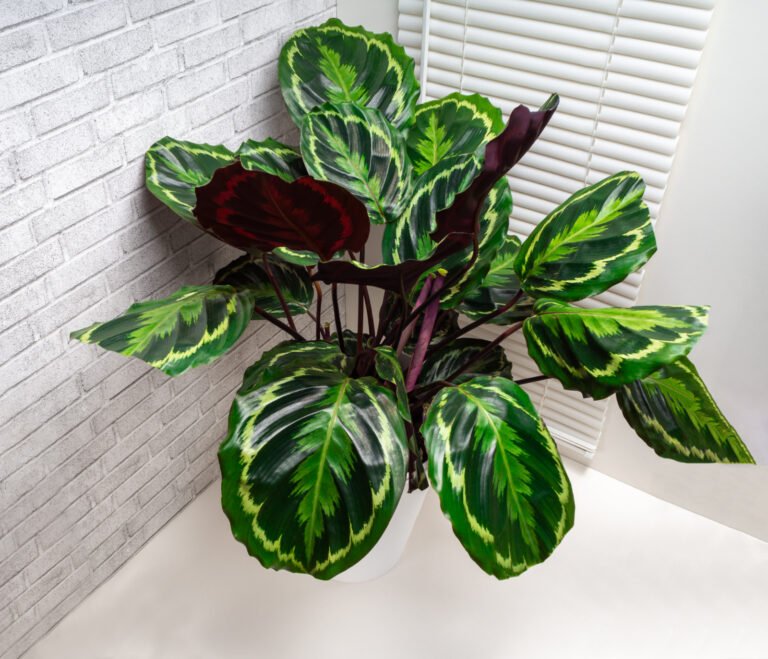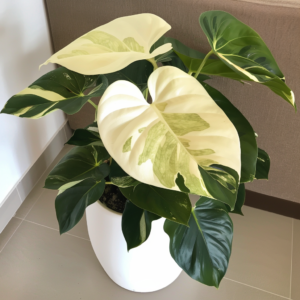Native to the tropical Americas, Calathea is the living artwork of the indoor plant world because of its uniquely patterned leaves. Another unique feature of this amazing indoor plant is the curling-up movement of its leaves at nighttime, giving it the nickname, prayer plant!
If you’re willing to grow a Calathea at your home but don’t know where to start, this Calathea plant care guide is just for you! Find the easy steps, plant care tips, and secrets that helped me grow a massive, lush Calathea plant!
Step 1: Plant Calathea In a Compost & Soil Mix
The best soil to plant and grow a Calathea plant is well-draining potting soil, like a half-and-half mix of compost and perlite. You can use coco peat, peat moss, and vermicompost.
Step 2: Give It Bright Indirect Sunlight
Calatheas thrive in bright indirect light but don’t like harsh, direct sunlight. Mine stays happy near the living room window where it gets plenty of bright light for about 10-12 hours of light in the day, but no direct sun.
This plant can also survive and grow (slowly) even in shade or low-light conditions but not under direct light; its leaves will start to fade and turn yellow. So, if you want your Calathea to flourish, give it ample indirect light.
Step 3: Keep It In Humid Areas
Since Calathea is a tropical plant, it likes humid environments with at least 50-60% humidity. If your plant’s surroundings are too dry, the foliage will start browning on the tips or wilting.
You can either keep your Calathea in a humid area. I kept mine in my bathroom window, and it helped.
But that’s not the only way. You can also do regular misting to keep Calathea leaves moist. Or, place your plant pot on a pebble tray (a tray filled with water and pebbles). Another secret way is to put a humidifier near the plant.
Step 4: Water It Every 1-2 Weeks
Calathea prefers moist soil in growing seasons, that is, summer and spring. So, water your plant every one or two weeks. If you’re not sure about the watering frequency, check the moisture in the soil.
When the topsoil is 25% to 40% dry, water it amply, letting the excess water drain through the drain holes. Don’t leave the soil waterlogged.
While the plant is sensitive to excessive dryness, it prefers less watering In winter or fall. So, water it enough to keep the soil moist with longer gaps between each watering.
TRY this: Use distilled water for your Calathea plant. Mineral or tap water may cause fungal infection due to excessive minerals, resulting in leaf spots or yellowing.
Step 5: Maintain a Warm Temperature
My Calathea plant grows well in moderate to warm temperatures ranging from 60 to 85 degrees (18°C-30°C). If the temperature goes below 59-60 degrees, your Calathea can be at risk of a cold drought.
So, if it’s too cold, bring the plant to a warmer room with a fireplace. And if the weather is too hot, water your Prayer Plant regularly.
Step 5: Feed It In the Growing Season
During spring and summer, I feed my Calathea on a monthly basis and it’s been growing decently! If you don’t want your houseplant to grow too much, you can fertilize it every couple of months.
You don’t have to feed your Calathea at all in winter or fall, as they’re mostly dormant and calm.
As for the choice of fertilizer, use the one with the 10-10-10 or 20-20-20 composition of phosphorus, potassium, and nitrogen. Any regular house plant fertilizer with even amounts of these nutrients will work fine.
How to Know If Your Calathea Is Underfed?
It’s simple! If your Calathea plant is healthy but isn’t growing or setting new leaves even in the blooming season of spring and summer, it likely needs fertilization. Or if its leaves are reaching their full sizes, it might be underfed.
Step 6: Take Good Care of the Leaves
I clean my Calathea leaves regularly using a damp sponge or cloth and sometimes spray a natural pest deterrent solution. If your plant is small, you can take it to the sink and water flush the leaves as you water it. If it’s big, clean each leaf from both sides using a damp cloth.
While using a pest deterrent solution, simply spray it on the foliage and clean it using a clean and soft wipe cloth. Another method is to remove the dirt and dust from the leaves using the brush.
Step 7: Repot It Every Two Years
While the plant doesn’t like frequent repotting, you can shift it to a larger pot if you want it to outgrow its current size.
I repotted my Calathea plant two years back in early springtime into a larger pot than my earlier one, and the plant has shown tremendous growth.
The most important thing to remember while repotting is to shift the plant along with the roots to the newer pot with a fresh soil mix. Look for root rot, but try not to disrupt the root system.
Step 8: Don’t Prune It Unnecessarily
Calatheas don’t need regular pruning to grow. So, the only thing to prune off is the yellow or dead leaves on the plant and the flower stalks after the flowers have bloomed.
As you can see, growing a lush Calatheas isn’t really that difficult! You just need to mimic their natural habitat using the steps given in this plant care guide and they will thrive.
Anthurium is another indoor plant that thrives in regular indoor conditions. Learn more about Anthurium plant care now!




